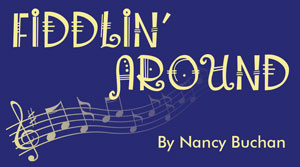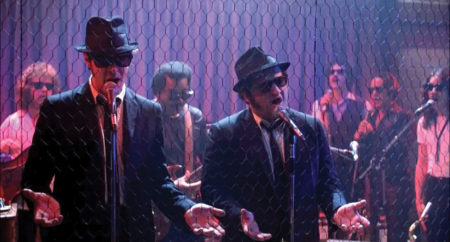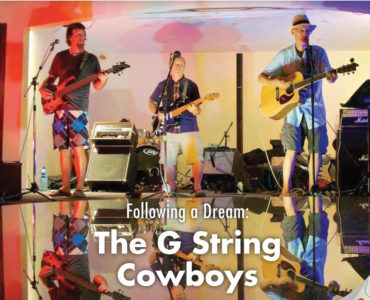Fiddlin’ Around – August 2019
 All songwriters start out with a scary blank page, and most of them have their own particular approach for filling it up. Everybody’s got to find the muse and method that works for them, but like most artistic endeavors there is no one ‘right’ way to go about writing a song. There are lots of different reasons for writing a song—to tell a story, to make a buck, to give yourself or another singer a vehicle for showing what they are capable of, to influence others, or because that’s just what songwriters do! There are books written on the subject, and plenty of folks with advice about how to write a hit song, but eventually it’s all gonna boil down to HONESTY and HEART. Of course it is useful to learn how to read music and to understand keys and scales and harmony—but somehow the listener can always tell when music is fake or contrived and it just doesn’t work.
All songwriters start out with a scary blank page, and most of them have their own particular approach for filling it up. Everybody’s got to find the muse and method that works for them, but like most artistic endeavors there is no one ‘right’ way to go about writing a song. There are lots of different reasons for writing a song—to tell a story, to make a buck, to give yourself or another singer a vehicle for showing what they are capable of, to influence others, or because that’s just what songwriters do! There are books written on the subject, and plenty of folks with advice about how to write a hit song, but eventually it’s all gonna boil down to HONESTY and HEART. Of course it is useful to learn how to read music and to understand keys and scales and harmony—but somehow the listener can always tell when music is fake or contrived and it just doesn’t work.

My intention in this article was to write about Ken Nickell, a singer, guitarist and super prolific songwriter who has lived in Ojochol for the last 17 years. To me, Ken is a fascinating songwriter, partially because he writes in so many different styles and about so many different topics. Ken has written hauntingly beautiful love songs. He has written hymns to a higher power right after writing a raunchy song about worn out hookers. He is often very funny and writes about all types of people and their histories, and seems to be able to turn even ordinary conversation into lyrics! I overheard someone ask him where he was from—you know, the basic conversation starter down here when you meet newcomers. He replied he was “Born in a nursing home in eastern Kansas in 1950, and his folks weren’t poor, just a little thrifty. They didn’t have much, but they didn’t need any more.” Sounds like lyrics to me! Did I mention lyrics don’t have to be true to be good? Just honest.
Ken started singing locally at age 5, and learned about different types of farming the hard way – out there sweating and dealing with animals and big machinery and the uncertainty of trying to raise crops. Figuring that was just too hard, he went to college and got a degree in agriculture. In the 90s he went back to college and got a biology degree, taught for a few years, farmed for a few years, and eventually discovered some kind of microscopic critter only scientist types are much interested in. He’s traveled all over and has endured many hardships. He has 7 kids—2 toddlers and 5 grown kids with kids of their own. I heard him say once he was bummed out that his 2 older boys (beginner week-end musicians) wanted to go to college instead of sticking around so they could all play in a band together! Now when have you ever heard a parent say that?
He’s certainly had an interesting life, paid his musical dues and he puts his experiences into his songs and the people whose lives he has crossed are immortalized in his words. Ken is excellent at setting a mood with his lyrics, and can take small moments of love and trust and despair and make us feel them. He can describe a place or time and cause us to feel like we are there. Talk about a hook—his song Fresh Batch of Brownies has morphed into a local anthem, with the audiences singing along to the line, “I got a fresh batch of brownies and a cold Imperial!”
 Some songwriters look for the hook first—hoping for that one-liner truism that will be catchy enough for everyone to sing along to or at least to remember. Sometimes the hook is instrumental—think about the guitar riff that starts out the Stones song Satisfaction, or Hendrix’s guitar riff in the beginning of Purple Haze. Jimi found 2 hooks in that song—the guitar intro, which everyone now recognizes in about 3 notes, and he starts every verse with two words that were the quick and hip new drug lingo for LSD.
Some songwriters look for the hook first—hoping for that one-liner truism that will be catchy enough for everyone to sing along to or at least to remember. Sometimes the hook is instrumental—think about the guitar riff that starts out the Stones song Satisfaction, or Hendrix’s guitar riff in the beginning of Purple Haze. Jimi found 2 hooks in that song—the guitar intro, which everyone now recognizes in about 3 notes, and he starts every verse with two words that were the quick and hip new drug lingo for LSD.
The hook is a rhythmic, melodic or lyrical idea, a fragment really, which often includes the song title, and is usually repeated throughout the song. Writers strive to find a catchy and memorable hook. Most writers believe it should be short and clear, but it can be any instrument or voice, and can appear anywhere in the song and then disappear for a while. The hook almost always arrives via the KISS method—or in the music world, we say KEEP IT SIMPLE STUPID! Even classical composers knew about starting with a hook—think of Beethoven’s 5th Symphony, where he grabs you by the balls on the very first powerful killer phrase, and then repeats it throughout the piece in new and interesting ways. Although in the exalted world of classical compositions they’d probably describe it as a ‘thematic passage’.
 Bob Dylan is a master at this hook thing—it’s no mistake he is, well, Bob Dylan. In the song Don’t Think Twice, that line is the hook, but it only comes up vocally at the end of every 2 verses, and there are 8 total verses. An unusual style which would not work for a lesser lyricist. His anthem Blowing in the Wind, has 9 lines that start with a question, “How many…” And it has 8 lines that reply with “The answer is blowing in the wind.” Lots of writers screw things up when they look too hard for the hook and then if they find one they beat you up by re-stating it over and over. While sometimes that approach really works, especially for a while, even the coolest hook or best lyrics can also be annoying and sound moronic after you hear it a kzillion times.
Bob Dylan is a master at this hook thing—it’s no mistake he is, well, Bob Dylan. In the song Don’t Think Twice, that line is the hook, but it only comes up vocally at the end of every 2 verses, and there are 8 total verses. An unusual style which would not work for a lesser lyricist. His anthem Blowing in the Wind, has 9 lines that start with a question, “How many…” And it has 8 lines that reply with “The answer is blowing in the wind.” Lots of writers screw things up when they look too hard for the hook and then if they find one they beat you up by re-stating it over and over. While sometimes that approach really works, especially for a while, even the coolest hook or best lyrics can also be annoying and sound moronic after you hear it a kzillion times.
There are classic lines that have affected all of us—the hooks from hell that can drive us nuts. “A horse is a horse, of course of course…” from the Mr. Ed TV show. The Stones “You can’t always get what you want…” or the Beatles “Can’t buy me love” or Bruce being “Born in the USA”. “Peaceful easy feeling” makes me queasy nowadays and how about that anthem with the easiest to remember lyrics ever, “I love rock and roll, put another quarter in the juke box, baby…”, or even “Happy trails to you…” The song Rawhide says the word “Rolling” 12 times in the beginning, and it was a hit on TV and many years later with the Blues Brothers.
 I forgot to ask Ken how many songs he has written, but it’s probably in the hundreds. I have liked almost all of the ones I have heard, and here is one of my favorites. It has a beautiful melody, room for lovely harmonies and I love the lyrical hook.
I forgot to ask Ken how many songs he has written, but it’s probably in the hundreds. I have liked almost all of the ones I have heard, and here is one of my favorites. It has a beautiful melody, room for lovely harmonies and I love the lyrical hook.
“Every time I come home late at night, she’s always sitting there by the light. I can tell she’s waited for a while, by the pain and redness in her eyes. And she’s one step closer to being one step farther, one step farther away. I could tell you that I didn’t see it coming. I could tell you that the reasons weren’t clear. But don’t listen to the stories I’m repeating—it ain’t nothing but excuses that you’ll hear. I wish I had my life to live over—all the things I’d do different if I could. But the truth is I can never live another and I don’t think I ever understood that she was one step closer to being one step farther. One step farther away.”
Please come out and enjoy some live music in our area! Ken plays regularly at the Bamboo Room in Ojochol by himself and also with the great G-STRING COWBOYS, made up of Ken, Shorty Hill, and Tim Rath. Ken and I can often be found Friday nights at Roca Verde in Dominical. Dominical has a nice little baby music scene going on, so come on south and check it out! All of us musician types enjoy life more when someone is listening!
 Listen to Ken’s music at soundcloud.com/kennickell.
Listen to Ken’s music at soundcloud.com/kennickell.
“To play a wrong note is insignificant; to play without passion is inexcusable!” Ludwig van Beethoven
“Fifty bars of rap don’t translate onstage. No matter how potent the music, you lose the crowd. They want a hook. They want to sing your stuff back to you.” Drake
“Dark are the nights—bright are the stars. The deeper the cuts—the harder the scars.” Ken Nickell

